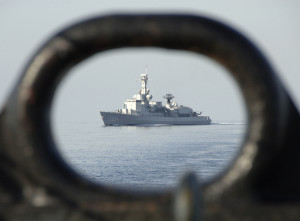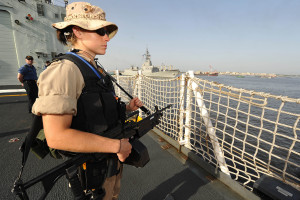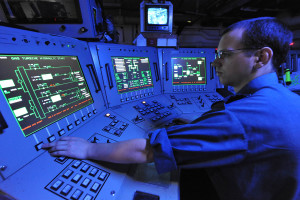It is hard to know what is meant by the word ‘war’ anymore. ‘War’ has been declared on such things as terror, drugs, and now, most bizarrely, mosquitoes as the Brazilian government reacts to the threat posed by the Zika virus to the upcoming Summer Olympic Games.
Canada has not declared war on another state since the 1940’s, although there has been plenty of conflict and military action since then. The problem is that while a conventional war between military forces is less and less prevalent, governments still expect to exert power when a threat is identified.
The new security environment includes problems like asymmetric conflict amongst the people and operations by proxy forces are the norm.
How then do we plan for future defence forces and what technologies will they require to enable their capabilities and counter those of potential enemies?

Most often, militaries begin their efforts with a future trends analysis before new acquisitions are made.
The Canadian Armed Forces’ first attempt at this occurred in 2010 with their release of The Future Security Environment 2008-2030. Part one of this landmark document describes today’s world as we know it, plus emerging trends that will shape the future. It does a very credible job of making logical deductions incomprehensible terms.
The future will be more like today
In general, the report predicts a complex environment that “contains a plethora of potential threats, adversaries and actors with divergent motivations not limited to traditional theories of international relations.”
The outcome is that all departments of the federal government will be required to contribute to a cooperative effort, often in combination with other levels of government, allies, coalition partners, non-government organizations and volunteers, to build effective teams and produce appropriate effects. In other words, the future will be more like today than the past and it will continue to change unpredictably.
Hear from military personnel what Canada is looking to invest in to better support and enhance its C4ISR systems. Click on the logo below
The key words for future force planners are “awareness,” “adaptive,” “flexible,” and “scalable.” Single-service interpretations of capability requirements are largely a thing of the past.

The section on Science and Technology Trends concisely presents a host of challenges to conventional approaches to naval force development and generation. It identifies several technologies that need to be watched closely and analysed carefully by naval leaders. All of them are characterized by rapid change and dramatic influences on military systems.
Nanotechnology will create microscopic “bots” capable of independent operations. While often viewed as positive influences in the fields of medicine and industrial production, their military application makes a wide range of invasive and developmental applications possible. “cheaper, lighter, and smaller” will be the watchwords for those who advocate the use of nanotechnology in the defence field.
The ICT revolution
Information and Computing Technology will drive a revolution in how data is gathered and analysed. Long considered essential for naval operations, information display and utilization will become critical for decision-makers in complex situations.
Likewise, the abilities of naval analysts to make use of information will be facilitated by their intellectual capacity and mental flexibility. For deployed naval forces, the ability to stream and manipulate huge volumes of complex data will remain their primary requirement for effective operations. Bandwidth limitations will render otherwise
tactically competent forces combat ineffective and potentially even defenceless.
Biotechnology will bring positive applications in medical therapies and even enhanced human characteristics. However, they will also result in weapons of both wide and selective employment.

Photo: Warrant Officer Carole Morissette, Canadian Forces Combat Camera
Being able to target specific types of people or even individuals could make biologic weapons very selective, but also practically impossible to detect or filter.Sending naval forces to a region that has the means to produce advanced biological weapons means they will require advanced defensive capabilities to counter them.
More broadly, significantly expanded naval medical and joint expeditionary engineering capacities will be increasingly valuable as “first responders” to natural disasters and pandemics.
Read more from the Feb-Mar 2016 Vanguard issue:
The maritime response to the Ebola outbreak was conspicuously absent. Energy technology is already producing weapons that employ “directed energy” beams as an alternative to tradition kinetic projectiles. The threat from swarms of autonomous drones presents the prospect of all ordnance being expended before the threat is countered.
Moreover, missiles are expensive to procure and maintain plus their increasing size limits the numbers that can be carried and generally prohibits underway replenishment. The move to lasers and electromagnetic rail guns for defensive and offensive purposes removes the logistical limitation of magazine space but transfers it to energy generation and fuel capacity, which become limiting factors on operations. Underway sustainment will undoubtedly become the Achilles’ heel of future naval missions.
Enablers with limits
Technologies can be both enablers of operations and limitations on them.
Force multiplying systems (such as communications or logistics) can be disrupted by both direct and indirect means, presenting high-value targets to enemies that understand their importance. Although technology can present an offensive advantage, it is usually fleeting when confronted with an equally innovative and adaptive opponent.
The naval technologies of the future and the complex security problems to be faced indicate that a broadly diversified naval force structure is required. A single-purpose organization focused on a particular type of threat will present a capable counter to it but little else.
The complexity and unpredictability of the security environment predicted by The Future Security Environment 2008-2030 make the case for a new and radically different force structure from the navy of today or that which is being contemplated for the future.
Part of the obstacle to transformative change is imposed by the procurement system. Unit cost is driven down by the Treasury’Board by purchasing in large numbers. The 15-ship Single Class Surface Combatant program is a prime example.
Without making provision for the introduction of new technologies during the decades-long construction process and throughout the roughly 30-year service life of the ships, they are unlikely to be effective. The anticipated pace of technological change is simply too great. The problem of block purchasing has recently arisen with the eleven Hero-class vessels built for the Canadian Coast Guard. Intended for use on both coasts and in the Great Lakes, these ships will be confronted with a wide range of operating conditions and tasks.
Early reports from Halifax-based ships indicate that they have great difficulty coping with Atlantic sea states since their introduction last summer and fall. For a vessel intended for sovereignty
patrol and life-saving, this is more than a minor issue.
A mismatch between operational concepts of effectiveness and economy has resulted in a conflict of purpose. Clearly, a one-size-fits-all purposes approach will result in times and places where the capability is not adequate to the requirement to uphold the national authority and save lives at sea.
For low-end ship requirements, the Canadian shipbuilding industry should be very capable of designing and building vessels to suit domestic needs.
The problems become vastly more complex when considering the needs of long-range expeditionary operations into a high threat environment.
The current practice of designing a mid-range capability warship that can be had for a reasonable price is an approach that will not satisfy anyone but the Treasury Board. Future naval combat requirements will be for advanced capabilities which will be very expensive. Anything less will mean relegation to the sidelines or backlines of mission plans.
The idea that frigates are cost-effective because of their multipurpose nature will founder on their escalating cost to procure and the high cost of operation for local tasks, for which they are vastly overqualified.
The major problem will be their under qualification for their principal purpose, rendering the entire strategy, at least, a military failure, if not an industrial one.
Walk before you run
Understanding the nature of technological change raises an important question about whether or not the Canadian industrial base is currently capable of producing cutting-edge technical defence applications of the latest technical innovations.
As part of the ongoing developmental process, the maritime industrial base will need to “walk before it runs”.
If the generation of appropriate naval capabilities for a wide range of defence and security missions is the strategic goal, then uniformity does not logically support the future organizational intention. If responsiveness to change is not part of the vision for the industrial plan,then a strategic partnership with the most capable and reliable source, likely the United States, should be negotiated.
Knowledge transfer of information for key industrial capability development must be part of the agreement.
There are ways that variable geometry and flexible technology can be built into ship design but the need to update capabilities must be a stated intention from the outset.
The very idea that technology will provide new and essential options should be a key ingredient of naval force development. The costs will be great and will limit the notion of fleet-wide implementation.
As the shipbuilding process develops, the three key naval capability concepts to watch are in the development of global communications and broadband information handling systems, high energy generation and electrical weapon systems, plus significantly expanded logistical sustainment, all incorporated within a diversified fleet structure.
Advanced combat capability will be a crucial component of the naval future fleet, but its extraordinary cost and transient character will make it relevant to only a small and elite element of the navy.
The remainder should be focused on supporting joint force operations and enabling whole-of-government missions. This is what the future security study shows and what is the most logical and cost-effective response.


